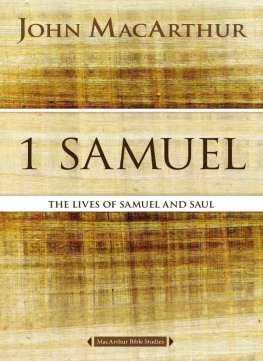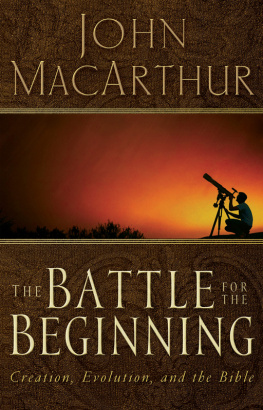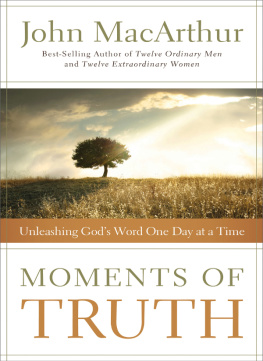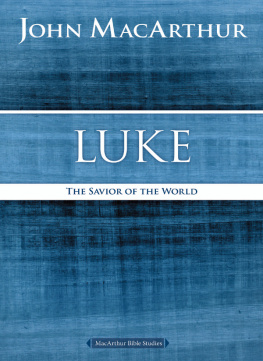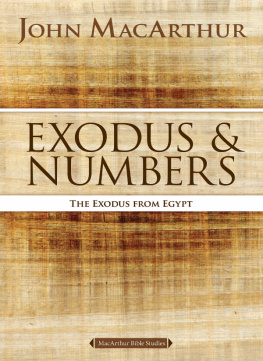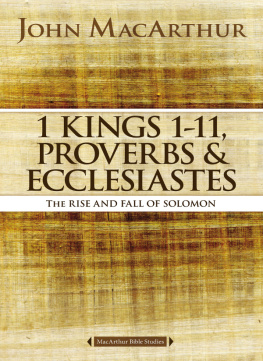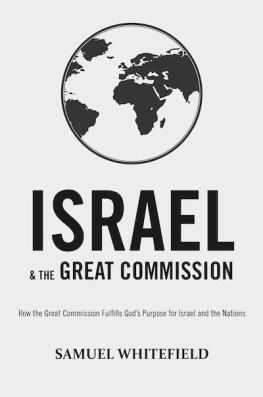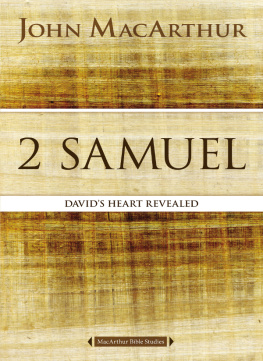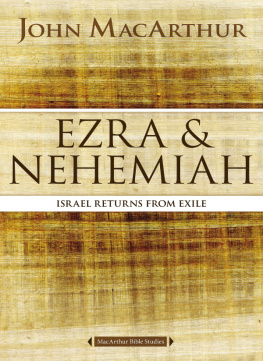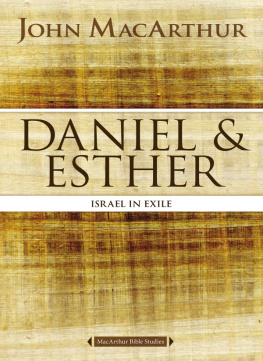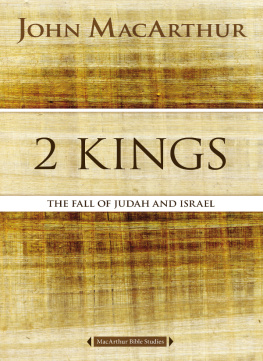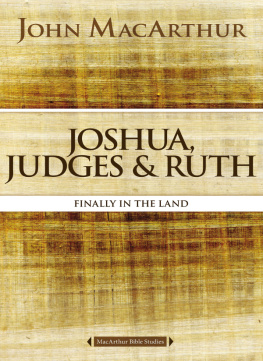MacArthur Bible Studies
1 Samuel: The Lives of Samuel and Saul
2016 by John MacArthur
All rights reserved. No portion of this book may be reproduced, stored in a retrieval system, or transmitted in any form or by any meanselectronic, mechanical, photocopy, recording, scanning, or otherexcept for brief quotations in critical reviews or articles, without the prior written permission of the publisher.
Published in Nashville, Tennessee, by Nelson Books, an imprint of Thomas Nelson. Nelson Books and Thomas Nelson are registered trademarks of HarperCollins Christian Publishing, Inc.
Originally published in association with the literary agency of Wolgemuth & Associates, Inc. Original layout, design, and writing assistance by Gregory C. Benoit Publishing, Old Mystic, Connecticut.
Unleashing Gods Truth, One Verse at a Time is a trademark of Grace to You. All rights reserved.
Thomas Nelson, Inc. titles may be purchased in bulk for educational, business, fundraising, or sales promotional use. For information, please e-mail SpecialMarkets@ThomasNelson.com.
Scripture quotations are taken from The New King James Version. 1982 by Thomas Nelson, Inc. Used by permission. All rights reserved.
Some material from the Introduction, Keys to the Text and Exploring the Meaning sections taken from The MacArthur Bible Commentary, John MacArthur, Copyright 2005 Thomas Nelson Publishers.
ISBN 978-0-7180-3472-6
ISBN 978-0-7180-3486-3 (eBook)
First Printing January 2016
CONTENTS
In this ebook edition, please use your devices note-taking function to record your thoughts wherever you see the bracketed instructions [Your Notes] or [Your Response]. Use your devices highlighting function to record your response whenever you are asked to checkmark, circle, underline, or otherwise indicate your answer(s).
A fter the Israelites settled into the Promised Land, a series of judges led the people for more than four hundred years. However, the Israelites eventually grew bored with that systemeven though it had been the Lords design. As the people looked around at the pagan nations of Canaan, they saw that everybody else had a kingand they wanted one of their own. Eventually, the Lord would grant their demands, but He would also warn that a king would bring with him a great deal of suffering for the nation.
In these twelve studies, we will examine the biblical events depicted in the book of 1 Samuel. We will become acquainted with the high priest Eli, and his two wicked sons, Hophni and Phinehas. We will meet Elis young protg, named Samuel, and examine his faithfulness. We will get to know Samuels mother, Hannah, and learn why the young boy was brought up by a priest in the temple rather than by his family at home. We will be introduced to Saul, Israels first king, and watch his sad decline. Finally, we will meet Sauls successor, David, who stood in marked contrast to his predecessor.
Through it all, we will learn some precious truths about the character of God, and we will see His great faithfulness in keeping His promises. We will learn, as did the prophet Samuel and King David, what it means to walk by faith.
TITLE
First and Second Samuel were considered one book in the earliest Hebrew manuscripts. They were later divided into two books by the translators of the Greek version, known as the Septuagint. This division was later followed by the Latin Vulgate, English translations, and modern Hebrew Bibles. The earliest Hebrew manuscripts titled the one book Samuel, after the man God used to establish the kingship in Israel.
AUTHOR AND DATE
Jewish tradition ascribed the writing of Samuel to the prophet himself or to Samuel, Nathan, and Gad (based on 1 Chronicles 29:29). However, Samuel cannot be the writer, because his death is recorded in 1 Samuel 25:1, before the events associated with Davids reign take place. Further, Nathan and Gad were prophets of the Lord during Davids lifetime and would not have been alive when the book was written. Thus, though the written records of these three prophets could have been used for information in the writing of 1 and 2 Samuel, the human author of these books is unknown. The work comes to the reader as an anonymous writing.
The books of Samuel contain no clear indication of the date of composition. However, it is clear the author wrote them after the division of the kingdom between Israel and Judah in 931 BC due to the many references to Israel and Judah as distinct entities. Also, the statement concerning Ziklags belonging to the kings of Judah to this day in 1 Samuel 27:6 gives clear evidence of a post-Solomonic date of writing. There is no such clarity concerning how late the date of writing could be, but most likely it was penned before the exile during the period of the divided kingdom (c. 931722 BC).
BACKGROUND AND SETTING
The majority of the action in 1 and 2 Samuel takes place in and around the central highlands of Israel. The nation was largely concentrated in an area that ran about ninety miles from the hill country of Ephraim in the north to the hill country of Judah in the south, and between fifteen to thirty-five miles east to west. The major cities of 1 and 2 Samuel were found in these central highlands: Shiloh, the residence of Eli and the tabernacle; Ramah, the hometown of Samuel; Gibeah, the headquarters of Saul; Bethlehem, the birthplace of David; Hebron, Davids capital when he ruled over Judah; and Jerusalem, the ultimate city of David.
The events in 1 and 2 Samuel occurred between the years c. 1105 BC (the birth of Samuel in 1 Samuel 1:128) and c. 971 BC (the last words of David in 2 Samuel 23:17). Thus, the books span about 135 years of history. During those years, Israel was transformed from a loosely knit group of tribes under judges to a united nation under the reign of a centralized monarchy. The books primarily examine the lives of Samuel (c. 11051030 BC); Saul, who reigned c. 10511011 BC; and David, who was king of the united monarchy (c. 1011971 BC).
HISTORICAL AND THEOLOGICAL THEMES
As 1 Samuel begins, Israel was at a low point spiritually. The priesthood was corrupt, the ark of the covenant was not at the tabernacle, idolatry was being practiced, and the judges were dishonest. Through the influence of Samuel and David, these conditions were reversed.
During the years narrated in 1 and 2 Samuel, the great empires of the ancient world were in a state of weakness. Neither Egypt nor the Mesopotamian powers, Babylon and Assyria, were threats to Israel at this time. The two nations most hostile to the Israelites were the Ammonites to the east and the Philistines to the west. The Ammonites were descendants of Lot (see Genesis 19:38) who lived on the Transjordan plateau. The major contingent of the Philistines had migrated from the Aegean islands and Asia Minor in the twelfth century BC. After being denied access to Egypt, they settled among other Philistines along the Mediterranean coast of Palestine. They controlled the use of iron, which gave them a decided military and economic advantage over Israel.
There are four predominant theological themes in 1 and 2 Samuel. The first is the Davidic covenant. The books are literally framed by two references to the anointed king in the prayer of Hannah (see 1 Samuel 2:10) and the song of David (see 2 Samuel 22:51). This is a reference to the Messiah, the King who would triumph over the nations who are opposed to God. According to the Lords promise, this Messiah would come through the line of David and establish Davids throne forever (see 2 Samuel 7:1216). The events of Davids life recorded in Samuel foreshadow the actions of Davids greater Son (Christ) in the future.
A second theme is the sovereignty of God. One example is the birth of Samuel in response to Hannahs prayer (see 1 Samuel 9:17; 16:1213). Also, in relation to David, it is particularly evident that nothing can frustrate Gods plan to have him rule over Israel.
Next page
